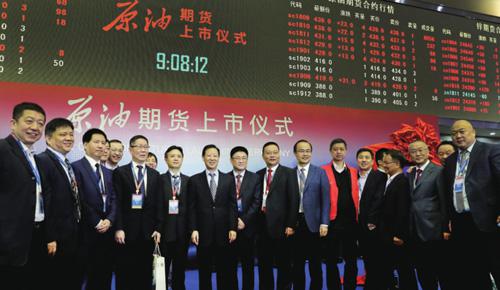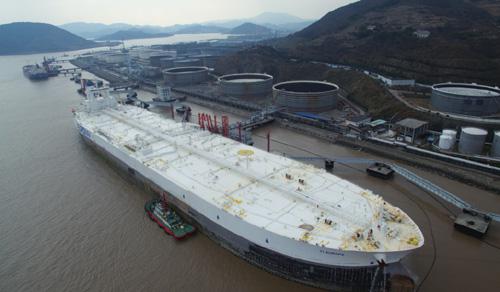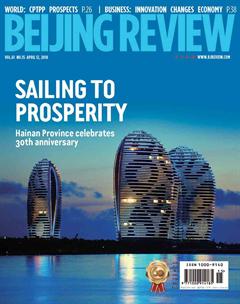Coming to the Game
By Wang Jun

Trading of yuan-denominated crude oil futures contracts opened on March 26 at the Shanghai International Energy Exchange (INE). As the fi rst international futures contracts on the Chinese mainland, they allow foreign investors to participate in transactions.
In the fi rst week of the new market, the 15 listed crude oil futures contracts recorded a total of 278,234 transactions, worth 115.92 billion yuan ($18.48 billion). By March 30, more than 20,000 trading accounts had opened at INE, including 25 percent held by institutional investors. In addition, 23 overseas agencies registered with INE to provide brokerage services for investors from outside the Chinese mainland.
Chinas crude oil futures, trading in medium sour crude oil, have a contract size of 1,000 barrels per lot and allow price fl uctuations up to 4 percent from the settlement price of the previous trading day, while the minimum trading margin is 5 percent of contract value.
Right time
The listing of Chinas crude oil futures went through a good deal of preparation. Seventeen years have passed since the Shanghai Futures Exchange, of which INE is a subsidiary, launched studies on oil futures in 2001.
Jiang Yang, Vice Chairman of the China Securities Regulatory Commission (CSRC), explained the reasons for Chinas launching of its own oil futures in his article written for Economic Daily.
Since 2004, according to Jiang, the AsiaPacific region has replaced North America and Europe as the largest oil consumption market in the world. In 2017, Chinas apparent consumption of crude oil, including domestic output and net import volume, reached 610 million tons and its oil imports stood at 420 million tons, overtaking the United States as the worlds largest crude oil importer for the fi rst time.
Asia-Pacific has huge crude oil consumption and imports, but in its time zone and region there is no mature futures market that can provide a pricing benchmark and risk-hedging tools for crude oil trade. Currently, Asia-Pacific countries including China must pay higher prices than European countries and the United States for crude oil imported from the Middle East, which is unfavorable for their economies, Jiang said.
As for the timing of Chinas launch of crude oil futures, Gao Jian, an analyst with Sublime China Information Co. Ltd., a commodities consultancy in Zibo, east Chinas Shandong Province, said the product is offered now because the policies and market conditions are mature.
Over the past few years, the Ministry of Finance, the State Administration of Taxation, the General Administration of Customs, the State Administration of Foreign Exchange, the CSRC and the Peoples Bank of China have revised their separate regulations associated with crude oil futures trading and these efforts helped formulate a set of sound systems and mechanisms for the operation of the new market, according to Gao.
Moreover, the institutional reform of the spot market enables local oil refi ners to have more autonomy over oil imports and use, diversifying the types of players in the crude oil market. In the meantime, supporting hardware, such as delivery warehouses, has improved greatly.
Contrasting with the two major crude oil benchmarks in the world—Brent and West Texas Intermediate (WTI) futures, which trade in light sweet oil—Chinas crude oil futures chose medium sour crude oil as the underlying asset for delivery.
“Among the crude oil imported by China, 43 percent is from the Middle East, which is its most important source of oil imports. Considering the structure of imported oil products and the demand of the real economy in China, INE chose medium sour crude oil as the trading product,” Jiang said.
Yuan-denominated
“Chinas crude oil futures are denominated and settled in renminbi, and the prices reflect the quotation of cost, insurance and freight of imported oil, which makes it easier for domestic oil-related corporations to manage risks brought on by oil price fl uctuations,” said Cheng Shen, Deputy Director of the CSRCs Department of Futures Supervision.
Initially, the U.S. dollar may be used as deposit and for settlement, and in the future, more currencies will be used as deposit, according to INE regulations.
Wang Jinzhao, Deputy Director of the Research Department of Foreign Economic Relations of the Development Research Center of the State Council, said for oil-exporting nations, promoting the settlement, pricing and transaction of oil trading in renminbi will help them prevent against exchange rate risks and save foreign exchange expenses while also facilitating the Chinese currencys internationalization process.
As for whether the overwhelming status of the U.S. dollar will be challenged, Wang said on the one hand, the petro-dollar has a longstanding dominance that cannot be weakened in a short time. On the other hand, the petro-yuan must not be simply regarded as seeking to replace the petro-dollar to become an overwhelming currency. The future international currency system should be diversifi ed, Wang said.
Significance
“Chinas crude oil futures market aims to provide an effective tool against price risks for enterprises to better protect themselves against market risks in their daily operations,”said a CSRC press release. Building a crude oil futures market is one of the signifi cant steps China is taking to open up and globalize its futures markets.
Although Europe and the United States already have mature crude oil futures markets, their prices cannot accurately refl ect the market situation in the Asia-Pacific region, according to the press release. It added that the launch of Chinas crude oil futures will help establish a pricing system as a benchmark to reflect the supply-demand relationship in the petroleum markets in China and the Asia-Pacifi c region more accurately while optimizing the allocation of oil resources to better serve the real economy.
A report by Ping An Securities Co. Ltd. in Shenzhen, south Chinas Guangdong Province, said in the global crude oil futures market, Brent and WTI are the benchmarks of global and U.S. spot crude oil prices, but in Asia-Pacifi c, the largest oil-importing region in the world, there is no such authoritative benchmark.
“Considering Chinas position in the global oil-importing market and its growing comprehensive national strength, the crude oil futures listed in Shanghai will become a better pricing benchmark for spot crude oil in the Asia-Pacifi c region,” said the report.
Fang Xinghai, CSRC Vice Chairman, said crude oil futures, as an innovative product, are also a gauge of the further opening up of the market. The CSRC will later launch new measures regarding crude oil futures to make international pricing benchmarks better refl ect the supply-demand conditions in China so as to boost the countrys economic growth, according to Fang.

